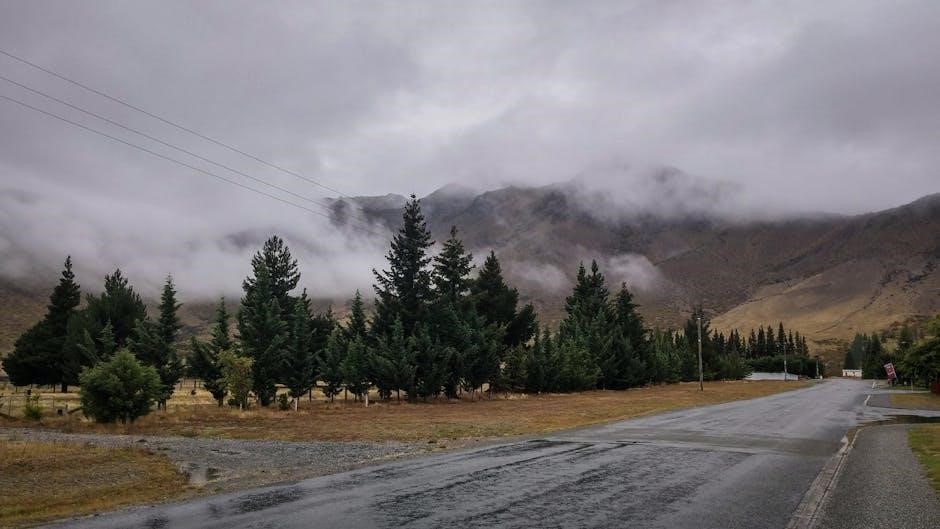Latitude and longitude are geographical coordinates defining Earth’s grid system. Latitude measures north-south positions, while longitude measures east-west, enabling precise location identification globally.
1.1 Definition of Latitude and Longitude
Latitude refers to the angular distance north or south of the Equator, measured in degrees up to 90° at the poles. Longitude measures east-west positions relative to the Prime Meridian, ranging from 0° to 180° east or west. Together, these coordinates provide a precise global location system, essential for navigation and mapping. Latitude lines are parallels, while longitude lines are meridians converging at the poles. This grid system is fundamental for understanding Earth’s geography and is widely used in education through worksheets and exercises.
1.2 Importance of Understanding Latitude and Longitude
Understanding latitude and longitude is crucial for navigation, cartography, and geography. These coordinates enable precise location identification, vital for aviation, maritime, and GPS technologies. In education, worksheets help students grasp spatial awareness and global positioning, enhancing their ability to interpret maps and analyze data. Mastery of this concept fosters practical skills in determining absolute locations, identifying hemispheres, and understanding Earth’s layout. It also aids in identifying oceans, continents, and countries, making it a foundational skill for various academic and professional applications.
Key Concepts in Latitude and Longitude
Latitude and longitude form Earth’s grid system, with latitude lines (parallels) running horizontally and longitude lines (meridians) vertically, intersecting at the Prime Meridian and Equator.
2.1 Lines of Latitude (Parallels)
Lines of latitude, or parallels, are horizontal circles around Earth, measuring distance north or south of the Equator. They range from 0° at the Equator to 90° at the poles. Each parallel is a specific distance from the Equator, decreasing in circumference as they approach the poles. These lines are crucial for determining locations and are used in mapping and navigation. Worksheets often include exercises where students identify and plot these lines, enhancing their understanding of Earth’s grid system.
2.2 Lines of Longitude (Meridians)
Lines of longitude, or meridians, are vertical circles passing through the poles, measuring distance east or west of the Prime Meridian. They range from 0° to 180° East and West. Unlike parallels, meridians converge at the poles, making them unique. Worksheets often feature exercises where students identify and plot these lines, aiding in understanding global positions. These exercises help learners visualize how meridians divide the Earth into eastern and western hemispheres, essential for mapping and navigation skills.
2.3 The Prime Meridian and Equator
The Prime Meridian and Equator are fundamental references in the latitude and longitude system. The Prime Meridian, at 0° longitude, divides the globe into eastern and western hemispheres. The Equator, at 0° latitude, separates the northern and southern hemispheres. Together, they intersect near Greenwich, England, forming the basis of global mapping. Worksheets often include exercises identifying these lines, helping students understand their role in determining absolute locations and navigation. These concepts are essential for mastering coordinate systems and are frequently featured in educational resources.

Reading Latitude and Longitude Coordinates
Latitude and longitude coordinates pinpoint locations using degrees, minutes, and seconds. Worksheets help students interpret these measurements, understanding hemispheres and their role in precise location identification.
3.1 Degrees, Minutes, and Seconds
Latitude and longitude are measured in degrees, minutes, and seconds, providing precise location identification. Degrees are the primary unit, with 90 degrees from the equator to each pole for latitude and 180 degrees east and west for longitude. Minutes and seconds further divide degrees, enabling finer accuracy. Worksheets often include exercises converting between decimal degrees and degrees-minutes-seconds, enhancing understanding of coordinate systems. This measurement system is essential for accurate mapping and navigation, allowing users to pinpoint locations globally with precision.
3.2 Hemispheres and Their Significance
Hemispheres divide the Earth into northern and southern (latitude) and eastern and western (longitude) sections. The equator separates the northern and southern hemispheres, while the prime meridian divides the eastern and western hemispheres. Understanding hemispheres is crucial for identifying global locations and time zones. Worksheets often include exercises identifying hemispheres for given coordinates, helping students visualize Earth’s spatial organization. This knowledge aids in mapping continents, oceans, and countries, enhancing geographical awareness and navigation skills. Hemispheres provide a foundational framework for interpreting latitude and longitude coordinates accurately.
Types of Latitude and Longitude Worksheets
Worksheets include basic identification, mapping exercises, and fill-in-the-blank questions, helping students master coordinates and geographical concepts through interactive and structured learning activities.
4.1 Basic Identification Worksheets
Basic identification worksheets focus on recognizing and plotting latitude and longitude coordinates. Students match coordinates to locations on maps or identify points from given coordinates. These exercises often include maps with grids, where learners plot cities, landmarks, or geographical features. Some worksheets provide coordinates for students to write the corresponding location names. This foundational practice helps build familiarity with the coordinate system, reinforcing the relationship between numbers and real-world places. They are ideal for introducing the concept to beginners or reinforcing skills in intermediate learners.
4.2 Mapping and Plotting Exercises
Mapping and plotting exercises involve using latitude and longitude to identify locations on a map. These exercises often include blank maps where students plot coordinates for cities, countries, or natural features. Activities may require connecting points to form shapes or borders, enhancing spatial awareness. Some worksheets include tracing lines of latitude and longitude, helping students visualize Earth’s grid system. This hands-on approach engages learners and strengthens their ability to interpret geographical data, making abstract concepts more tangible and easier to understand through practical application.
4.3 Fill-in-the-Blank and Multiple Choice Questions
Fill-in-the-blank and multiple choice questions test students’ understanding of latitude and longitude concepts. These exercises often ask for coordinates, hemispheres, or geographical features. Worksheets may include identifying the correct degree measurements or determining the hemisphere of a given location. Multiple choice questions provide structured options, making it easier for learners to assess their knowledge. These formats are ideal for reinforcing key terms and concepts, ensuring students can apply their understanding of Earth’s grid system accurately and confidently in various geographical contexts.

Practical Applications of Worksheets
Worksheets help determine absolute locations, identify oceans, continents, and countries, and enhance navigation skills, making them essential tools for real-world geographical applications and problem-solving.
5.1 Determining Absolute Location
Worksheets are invaluable for determining absolute location, as they teach students to pinpoint exact positions using latitude and longitude coordinates. By plotting these coordinates on maps, learners can identify cities, landmarks, and geographical features accurately. This skill enhances understanding of global positioning and spatial awareness. Practical applications include navigation, geography, and environmental studies, where precise location data is critical. Worksheets also help students recognize hemispheres, aiding in broader geographical context and real-world problem-solving. Mastering absolute location is fundamental for various academic and professional fields, making worksheets an essential educational tool.
5.2 Identifying Oceans, Continents, and Countries
Worksheets are excellent tools for identifying oceans, continents, and countries using latitude and longitude. By plotting coordinates, students can locate specific geographical features and understand their global positions. Activities include matching coordinates to regions, labeling maps, and answering questions about hemispheres. This practice enhances spatial awareness and familiarity with Earth’s layout. Worksheets often feature exercises where students link coordinates to major bodies of water, landmasses, and nations, fostering a deeper understanding of global geography. Such skills are essential for developing a strong foundation in environmental studies, travel, and international relations.

Sources for Latitude and Longitude Worksheets
Latitude and longitude worksheets are available on educational websites like Super Teacher Worksheets and Scribd, offering downloadable PDFs for easy access and printing.
6.1 Educational Websites and Resources

Educational websites like Super Teacher Worksheets and Scribd offer a variety of latitude and longitude worksheets in PDF format. These resources provide interactive exercises, mapping activities, and quizzes to enhance learning. Websites such as Education.com also feature comprehensive guides and printable materials. Additionally, platforms like Teachers Pay Teachers and Google Classroom host downloadable worksheets designed for different grade levels. These resources are ideal for both classroom use and independent study, catering to diverse learning needs and styles.
6.2 Printable PDF Worksheets
Printable PDF worksheets on latitude and longitude are widely available online, offering convenient and structured learning materials. Websites like Scribd and educational platforms provide downloadable PDFs with exercises, maps, and quizzes. These worksheets often include activities such as plotting coordinates, identifying hemispheres, and matching locations with their lat-long values. Many PDFs are designed for specific grade levels, ensuring age-appropriate content. They are ideal for classroom activities, homework, or self-study, making them a valuable resource for educators and students alike to master geographic coordinates effectively.
Mastering latitude and longitude is essential for understanding global geography. PDF worksheets provide valuable practice, reinforcing concepts through interactive exercises. They serve as excellent resources for both educators and students.

7.1 Summary of Key Points
Latitude and longitude worksheets are vital tools for teaching and learning geographical coordinates. They help students understand how to identify locations, plot points, and distinguish between hemispheres. These resources, available in PDF formats, often include exercises such as identifying cities, continents, and oceans based on coordinates. They also cover concepts like the Prime Meridian and Equator, ensuring a comprehensive grasp of Earth’s grid system. Regular practice with these worksheets enhances spatial awareness and improves map-reading skills, making them indispensable for geography education.
7.2 Importance of Practice in Mastering Latitude and Longitude

Consistent practice with latitude and longitude worksheets is essential for mastering geographical coordinates. It enhances understanding of how to pinpoint locations, interpret maps, and distinguish between hemispheres. Regular exercises improve spatial awareness and the ability to apply these skills in real-world scenarios, such as navigation and cartography. Worksheets also build confidence in identifying oceans, continents, and countries based on coordinates. By reinforcing these concepts, practice ensures long-term retention and proficiency in using Earth’s grid system effectively.
